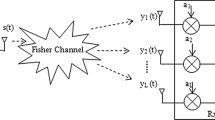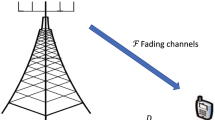Abstract
In contrary to Shannon’s ergodic capacity, the delay-constrained effective rate is used to define the maximum data rate of the real-time applications in 5G and beyond networks. The effective capacity (EC) performance of the delay sensitive communication system over Fisher-Snedecor F fading channel with maximum ratio combining is studied. The closed-form mathematical expressions for the EC are derived in terms of Meijer G-function and the effect of different fading parameters on the effective throughput of the system is demonstrated. The simplified asymptotic expression for high signal-to-noise ratio (SNR) and low SNR regimes are provided to gain more insight into the system. The effect of different system parameters on the EC performance is also demonstrated. Simulation results are corroborated along with the numerical results to verify the correctness of the proposed formulations.






Similar content being viewed by others
References
Wu, D., & Negi, R. (2003). Effective capacity: A wireless link model for support of quality of service. IEEE Transaction on Wireless Communications, 2(4), 630–643.
C. C. Tseng, K. C. Chen, and C. W. Su S. Y. Lien, "Cognitive radio resource management for QoS guarantees in autonomous femtocell networks," in IEEE International conference on communications (ICC), 2010.
Z. Nikolic, N. Milosevic, and P. Pirinnen S. Glisic, "Effective capacity of advanced wireless cellular ," IEEE 16th International symposium on personal indoor and mobile radio communications, vol. 4, pp. 2771–2780, 2005.
Xiangquna, S., & Qingxin, C. (2015). Effective capacity of cognitive radio systems in asymmetric fading channels. The Journal of China Universities of Posts and Telecommunications, 22(3), 18–25.
Piran, M. J., et al. (2020). Multimedia communication over cognitive radio networks from QoS/QoE perspective: A comprehensive survey. Journal of Network and Computer Applications. https://doi.org/10.1016/j.jnca.2020.102759
Zhang, X., & Du, Q. (2007). Cross-layer modeling for QoS-driven multimedia multicast/broadcast over fading channels in advances in mobile multimedia. IEEE Communications Magazine, 45(8), 62–75.
Fan, P., Wu, D. O., K. B. Letaief, K. B., & Wang, Q. (2011). "End-to-end delay constrained routing and scheduling for wireless sensor networks," in IEEE International conference on communications (ICC).
Chen. Y., & I. Darwazeh, I. (2011). "End-to-end delay performance analysis in IEEE 802.16j mobile multi-hop relay (mmr) networks," International conference on telecommunications, pp. 488–492 .
Huang, Y., Ren, P., Zhang, C., & Du, Q. (2011). "Statistical delay control and QoS-driven power allocation over two-hop wireless relay links," in IEEE Global telecommunications conference - GLOBECOM , Houston, TX, USA.
Chen, Y., & Darwazeh, I. (2013). "An estimator for delay distributions in distributions in packet-based wireless digital communication systems," in An estimator for d IEEE wireless communications and networking conference (WCNC), Shanghai.
Zhang, X., & Wang, J. (2017). "Heterogeneous QoS-Driven Resource Allocation over MIMO-OFDMA Based 5G Cognitive Radio Networks," in IEEE Wireless communications and networking conference (WCNC), San Francisco, CA.
Wang, J., & Zhang, X. (2017). "Statistical QoS-driven cooperative power ," in Wireless communications and networking conference (WCNC), 2017,pp. 1–6.
Chen, Y., Darwazeh, I., Philip, N., & Istepanian, R. (2013). "End-to-end delay distributions in wireless tele-ultrasongraphy medical systems," in IEEE Global communications conference, GA, USA, pp. 2592–2597.
You, M., Mou, X., & Sun, H. (2015). “Effective capacity analysis of smart grid communication networks,” in International workshop on computer aided modelling and design of communication links and networks, Guildford, UK, pp. 196–200.
Liu, L., & Chamberland, J. (2008). “On the effective capacities of multiple-antenna Gaussian channels,” in IEEE International symposium on information theory, Toronto.
Matthaiou, M., Alexandropoulos, G. C., Ngo, H. Q., & Larsson, E. G. (2012). Analytic framework for the effective rate of MISO fading channels. IEEE Transaction on Communication, 60(6), 1741–1751.
Ji, Z., Dong, C., Wang, Y., & Lu, J. (2014). "On the analysis of effective capacity over generalized fading channels," in IEEE Int. Conf. Commu.(ICC), Sydney, pp. 1977–1983.
Guo, X. B., Dong, L., & Yang, H. (2012). Performance analysis for effective rate of correlated MISO fading channels. Electronics Letters, 48(24), 1564–1565.
Kumar, S. (2018). Energy Detection in Hoyt/Gamma Fading Channel with Micro-Diversity Reception. Wireless Personal Communications, 101(2), 723–734.
Yadav, P., Kumar, R., Kumar, S. (2020). Effective capacity analysis over generalized lognormal shadowed composite fading channels. Internet Technology Letters, 3(5). https://doi.org/10.1002/itl2.171
Yadav, P., Kumar, S., & Kumar, R. (2021). "Analysis of EC over Gamma shadowed α–η–μ fading channel," in IOP Conference series: Material science & engineering p. 012010.
Yadav, P., Kumar, S., & Kumar, R. (2020). "Effective capacity analysis over α–κ–μ/Gamma composite fading channel," in IEEE Internatational conference on advances in computing,communication control and networking (ICACCCN), Greater Noida, India, pp. 587–592.
Yoo, S. K., et al. (2017). The Fisher-Snedecor F distribution: A simple and accurate composite fading model. IEEE Communication Letters, 21(7), 1661–1664.
Zhao, H., Yang, L., Salem, A. S., & Alouini, M. S. (2019). “Ergodic Capacity Under Power Adaption Over Fisher-Snedecor F Fading Channels,” IEEE communications letters.
Badarneh, O. S., da Costa, D. B., Sofotasios, P. C., Muhaidat, S., & Cotton, S. L. (2018). On the sum of fisher-snedecor F variates and its application to maximal-ratio combining. IEEE Wireless Communications Letters, 7(6), 966–969.
Adamchik, V., & Marichev, O. (1990). "The algorithm for calculating integrals of hypergeometric type functions and its realization in REDUCE system," in International conference on symbolic and algebraic computation, New York (USA), pp. 212–224.
Wolfram. ( 2017). Wolfram function site. [Online]. http://functions.wolfram.com/PDF/MeijerG.pdf
Prudnikov, A. P., & Brychkov, Y. A. (1986). Integrals and Series Volume 3, More Special Functions, 1st ed. Amsterdam: Gordon and breach science publishers.
Matthaiou, M., & Zhong, C. (2012). Low-SNR analysis of MIMO Weibull fading channel. IEEE Communications Letters, 16(5), 694–697.
Gradshteyn, I. S., & Ryzhik, I. M. (2000). Table of integrals, series and products (6th ed.). Academic press.
Funding
No funding was received for this work.
Author information
Authors and Affiliations
Contributions
All the authors have equally contributed in this manuscript.
Corresponding author
Ethics declarations
Conflicts of interest
The authors declare that they have is no conflict of interest.
Additional information
Publisher's Note
Springer Nature remains neutral with regard to jurisdictional claims in published maps and institutional affiliations.
Rights and permissions
About this article
Cite this article
Kaur, M., Yadav, R.K. Effective Capacity Analysis Over Fisher-Snedecor F Fading Channels with MRC Reception. Wireless Pers Commun 121, 1693–1705 (2021). https://doi.org/10.1007/s11277-021-08692-w
Accepted:
Published:
Issue Date:
DOI: https://doi.org/10.1007/s11277-021-08692-w




